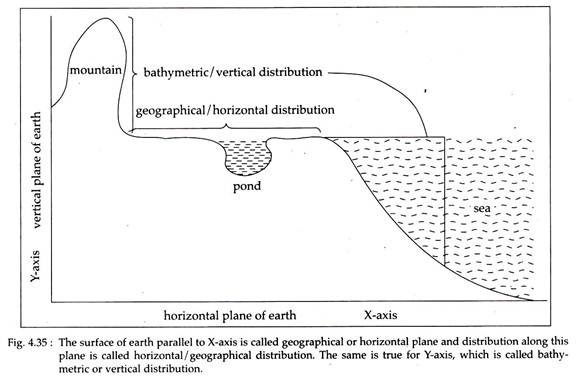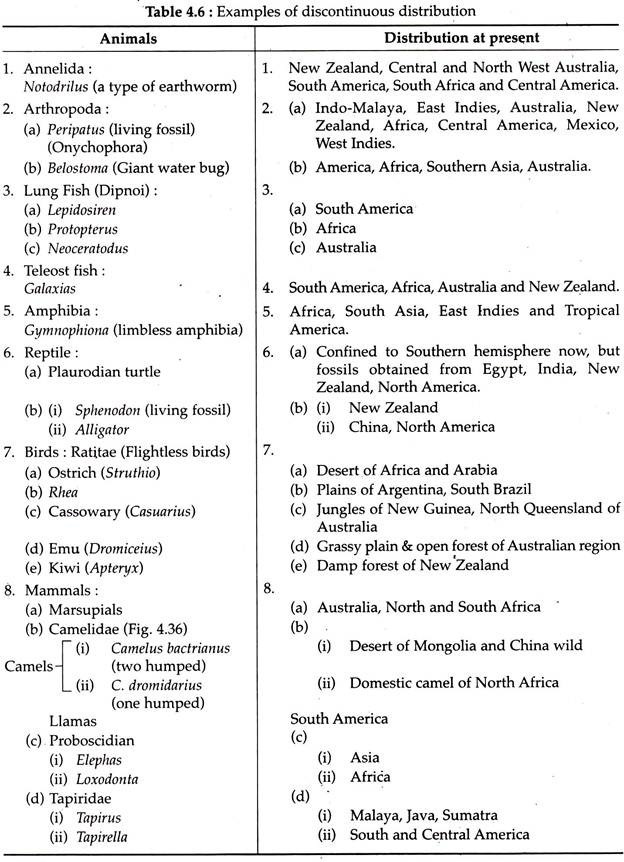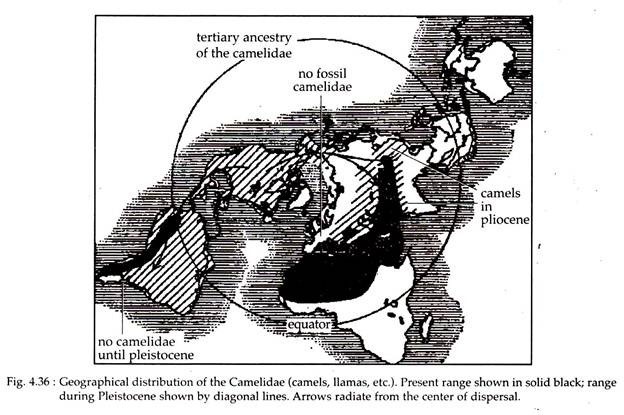Zoology Notes on Animal Distribution!
Animal Distribution: Type # 1. Distribution in Space:
In this type of distribution the arrangement of different types of animal on the earth’s surface is considered, i.e., animal’s distribution both on land and water.
This can further be sub-divided into two types:
(i) Geographical or Horizontal Distribution over earth’s surface,
ADVERTISEMENTS:
(ii) Bathymetric or Vertical Distribution.
(i) Geographical or Horizontal Distribution:
The distribution of animals on land and fresh water in different continents and on different islands is called geographical or horizontal distribution.
(ii) Bathymetric or vertical Distribution:
ADVERTISEMENTS:
The distribution of animals on the vertical surface of land and water is called the bathymetric or vertical distribution (Fig. 4.35). This type of distribution can be studied under three heads —
(a) Limnobiotic Distribution:
It deals with the distribution of animals in fresh water sources.
ADVERTISEMENTS:
(b) Holobiotic Distribution:
Distribution of animals in sea.
(c) Geobiotic Distribution:
Distribution of animals on land.
Animal Distribution: Type # 2. Distribution in Time:
The distribution of animals in the past of Earth’s history is called the distribution in time. This can be studied by fossil evidences only. The description of this type of distribution can be made on the Geological time scale.
Patterns of Distribution:
It is observed that animals are distributed everywhere in the environment. But the pattern and type of distribution is different for different animals.
There are generally four types of pattern recognised for animal distribution:
(a) Arctic distribution
ADVERTISEMENTS:
(b) Tropical distribution
(c) Continuous distribution, and
(d) Discontinuous distribution.
(a) Arctic Distribution:
A number of species are found to inhabit only in the Arctic or Antarctic waters with no representatives in the intermediate oceans. This type of distribution is called bipolar distribution and this characteristic is called as bipolarity.
Examples:
(i) Coelenterats: Botrynema, Grammaria, Lampta, Myriothela
(ii) Molluscs: Limacina helicina, Clione
(iii) Arthropoda: Peripatus
(iv) Ascidian: Didetnnus albidum
(v) Fishes: Oncorhynchus (salmon), Latnma cornubica
(vi) Birds: Aptenodytes (Penguin)
(vii) Mammals: Balaenoptera musculus (blue whale), Callorhinus (Seal), Caribou, etc.
(b) Tropical Distribution:
The distribution of animals on the landmass between Tropic of Cancer and Tropic of Capricorn are called tropical distribution. This region is having the maximum bio- diversity, i.e., the animals of all the phyla have developed enormously in this part. The faunal distribution of these areas are described in detail under the heading Oriental, Neo-tropical and Ethiopian realms in the chapter — zoogeographical realms.
(c) Continuous Distribution:
This is also called cosmopolitan distribution. When an animal is found over a wide area, i.e., uninterrupted range of surface distribution, then it is called continuous distribution.
Examples:
(i) Mollusca: The green mussel (Mytilus)
(ii) Arthropoda: Brine shrimp (Artemia salina), cockroach (Periplaneta)
(iii) Birds: Hawks, cuckoo
(iv) Mammals: Rats, bats, etc.
Those animals which can thrive over a large range of atmospheric change and have continuous distribution are called eurytopic’ animals, e.g., cockroach. On the other hand, the animals, which are restricted in a definite area are called ‘stenotopic’, e.g., Peripatus present in arctic areas only.
(d) Discontinuous Distribution:
When different species of same genus or different members of a species are living in different parts of the earth, then it is called discontinuous distribution.
Examples shown in Table 4.6.
Origin of Discontinuous Distribution:
There are several theories on the mode of origin of discontinuous distribution of animals. Among these, theories of P. J. Darlington (1957) and P. B. Weitz (1966) are accepted by the scientists. P. J. Darlington proposed that discontinuity in the distribution of animals may be due to;
(i) Reaching the oceanic islands across the water,
(ii) By the submergence of the landmass in between the ranges, and
(iii) By the extinction of the forms in the intermediate areas.
According to Weitz the animals can be distributed continuously or discontinuously by the following means:
(a) Sweeps take Bridges:
The sweeps take bridges appear accidentally on the water bodies, through which animals can be transported from landmass to islands or islands to islands. As for example, floating ice, log of wood, clinging mud on the bird’s claw or even bore of ship can mediate the transport of animals from one place to another. Most small oceanic islands are populated by sweeps take bridges.
In general, the islands have comparatively few species that are quite unique and are found nowhere else. Generally terrestrial mammals and amphibians are absent in islands. However, if present, they do resemble related species of the nearest mainland.
It is assumed that some animals of present day Madagascar island, like rat, cat, Lemur, small hippopotamus, were transported from nearest African mainland in the past via sweeps take bridges.
(b) Filter Bridge:
A filter bridge is a narrow land connection between two continents and has usually existed for only brief geological time period in the past. The main characteristics of a filter bridge are that it filters out many organisms of the connected regions, while permitting others to pass through. As the bridge’s duration was for a brief period, the shifted animals became isolated from each other.
North and South America was connected by a filter bridge during late Mesozoic era. This connection permitted the spread of marsupial mammals to the North America from South America, while ant-eater, sloth, etc. travelled from South America to North America during that time. Then the land bridges become submerged during Pleistocene and now the animals become restricted in these two continents only.
(c) A Corridor Bridge:
It is a broad land connection between continents, which persisted for long geologic periods and allowed free and substantial exchange of species. Europe and Asia was linked in part by a corridor bridge, which then got submerged during tertiary period. This is evident from the faunal composition of these areas, which are included in the same zoogeographical realm.


